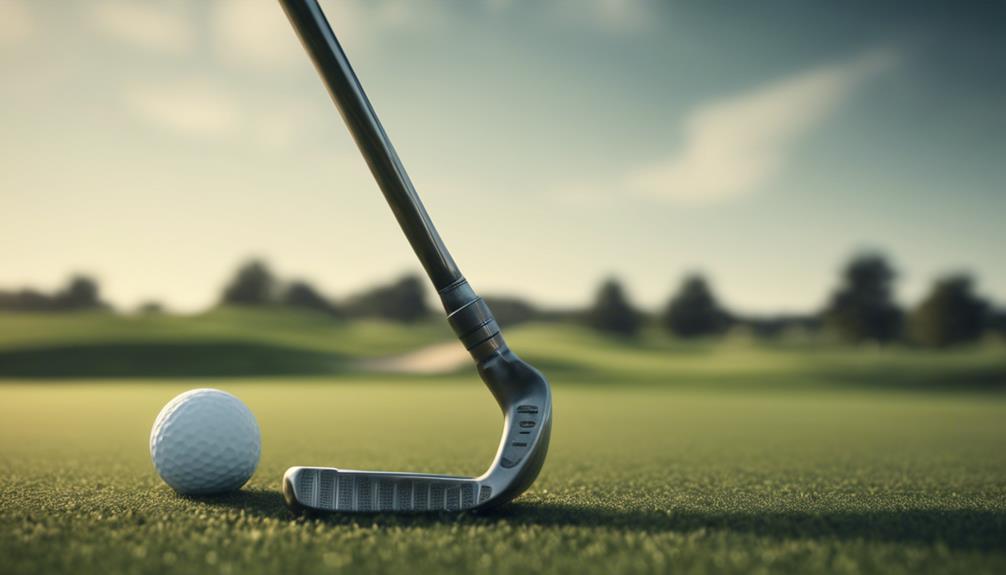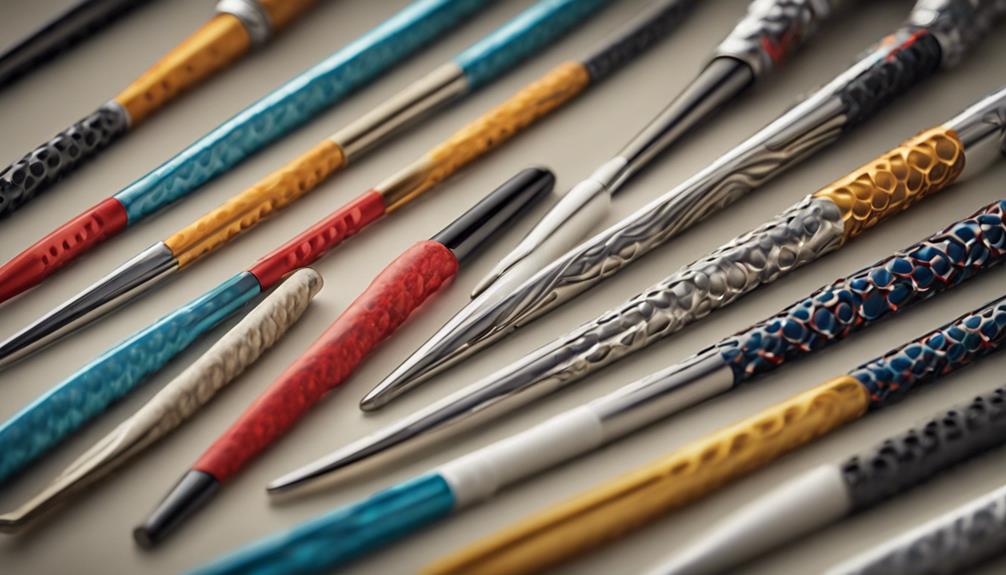- 7 Top Flite Golf Clubs XL for Improved Performance - September 28, 2024
- Top Flite Golf Clubs: Top 5 Reasons to Choose Them - September 28, 2024
- Top 3 Golf Club Fitters for a Perfect Swing - September 28, 2024
You'll find a ferrule, a small, cylindrical component, strategically positioned between the shaft and club head of your golf club, playing an important role in securing the connection and enhancing the aesthetic appeal of your club. The type of ferrule used depends on the hosel design, with flat or square hosels requiring ferrules and beveled hosels possibly not needing one. Proper specifications, including length and diameter, are vital for installation to guarantee a secure and durable connection. With various types and sizes available, it is important to understand the significance of proper sizing, installation, and maintenance to get the most out of your club, and there's more to explore about optimizing your ferrule's performance.
Key Takeaways
- A ferrule is a cylindrical component that secures the connection between the shaft and club head, enhancing the club's aesthetic appeal.
- The type of ferrule depends on the hosel design, with flat or square hosels requiring ferrules and beveled hosels potentially not needing one.
- Proper ferrule sizing is crucial, with accurate length and diameter ensuring a secure and durable connection between the shaft and hosel.
- Ferrules come in various sizes to match hosel diameters, with common sizes including 0.540 inches for irons and 0.500 inches for titanium drivers.
Understanding Golf Ferrules
When examining a golf club's construction, you'll likely notice a small, cylindrical component situated between the shaft and club head, known as a ferrule. This component plays an essential role in securing the two components together.
This plastic component provides a smooth visual shift from the hosel to the shaft, making it an integral part of the golf club's overall aesthetic appeal.
The type of ferrule you need depends on the hosel design; flat or square hosels require ferrules, whereas beveled hosels, like those on Ping irons, don't. You'll find standard and repair ferrules in various sizes to match different hosel diameters.
Collared ferrules feature a flange that fits into the hosel's countersunk area, reducing stress on the shaft during play, while uncollared ferrules rely on epoxy for attachment.
Understanding the specifications of ferrules, including their length and diameter, is vital for proper installation. By choosing the right ferrule, you can guarantee a secure and stress-reduced connection between the shaft and club head, resulting in improved overall performance.
Ferrule Types and Functions
With multiple ferrule types available, each serving a distinct purpose, it's essential to understand their unique characteristics and functions to guarantee the right choice for your golf club's specific needs.
Standard ferrules are the most common, used across various club types, while collared ferrules provide added stability and stress reduction on the shaft.
Repair ferrules, on the other hand, are designed to fix damaged hosels or accommodate specific club designs, often acting as hosel reducers for fitting smaller shafts into larger hosels.
When working with graphite shafts, collared ferrules provide additional support and cushioning, whereas uncollared ferrules rely solely on epoxy for attachment.
Ferrules come in various sizes to match different hosel diameters, with typical iron hosel diameters around 0.540 inches and titanium driver hosels measuring approximately 0.500 inches.
Custom and aftermarket ferrules offer aesthetic personalization, allowing you to enhance the visual appeal of your golf clubs.
Installation and Compatibility

Properly installing a ferrule requires attention to detail, as you must guarantee the epoxy application is even and the ferrule diameter precisely matches the hosel to prevent shaft movement and potential breakage.
The design of the hosel also plays an important role in ferrule installation, as beveled hosels may not require a ferrule, while flat or square hosels typically do. When selecting a ferrule, verify the length corresponds to the hosel length for best aesthetics and functional performance.
Compatibility between ferrules and shafts is essential, and standard ferrules are available in various inside and outside diameters to match differing hosel sizes across club types.
If you've improperly fitted a ferrule, don't worry – experienced clubmakers can re-set it for you. However, correct sizing and installation techniques are necessary for maintaining club integrity.
Importance of Proper Sizing
You'll find that accurately sizing your ferrule is vital to guaranteeing a secure and durable connection between the shaft and hosel. Ferrules come in various inside and outside diameters, so it's important to select the correct size for your clubhead.
Common hosel sizes for irons are around .540 inches (13.7mm), while titanium drivers measure close to .500 inches (12.7mm). Proper sizing eliminates the need for sanding, which can weaken the shaft or hosel if not done carefully.
Additionally, the length of the ferrule should match the hosel length for best aesthetics and performance. Inaccurate ferrule sizing can lead to gaps that require epoxy to fill, potentially affecting the structural integrity and performance of the club. This can compromise the overall cosmetic appeal of your club as well.
Specialty Ferrules Explained

As you explore the world of specialty ferrules, you'll find that repair ferrules are designed to rescue damaged hosels, while others address clubhead compatibility issues.
You'll need to take into account the unique demands of your clubhead when selecting a ferrule, as some require custom solutions not offered by mainstream manufacturers.
Repair Ferrule Uses
When clubheads become detached from their shafts due to damaged hosels, repair ferrules step in to save the day, allowing you to reattach the clubhead without replacing the entire club.
These specialty ferrules are designed to address damaged hosels, providing a secure and durable connection between the clubhead and shaft.
Additionally, repair ferrules can function as hosel reducers, enabling smaller diameter shafts to fit securely into larger hosel openings. This is particularly useful for custom fitting, where precise measurements are essential.
Some OEMs manufacture repair ferrules specifically for use with 0.350 hosels, guaranteeing compatibility with a variety of club types. Aftermarket options may also be available for unique designs or sizes not offered by original manufacturers.
To guarantee a secure fit, proper installation of repair ferrules typically requires professional assistance, especially when dealing with significant hosel damage.
Clubhead Compatibility Issues
Specialty ferrules come into play when clubhead compatibility issues arise, necessitating precise solutions to bridge the gap between varying hosel sizes and shaft diameters. As a golfer, you may encounter issues with fitting smaller shafts into larger hosels, which can be addressed by using specialty ferrules designed for this purpose. For instance, some clubheads from original equipment manufacturers (OEMs) require specific ferrules, such as hosel reducers, that may not be readily available through standard retail channels.
| Clubhead Feature | Specialty Ferrule Solution |
|---|---|
| Adjustable Driver | Larger ferrules for stress distribution and stability |
| OEM Clubheads | Hosel reducers for precise fit |
| Damaged Hosels | Repair ferrules for secure shaft fit |
| Unique Club Designs | Customized ferrules for precise compatibility |
| Performance Critical Clubs | Precision-manufactured ferrules for peak performance |
When dealing with clubhead compatibility issues, it is crucial to prioritize precision manufacturing to guarantee proper fit and prevent performance issues or damage. By understanding the specific requirements of your golf club, you can select the right specialty ferrule to enhance your game.
Maintenance and Replacement Tips
As you take on the task of maintaining and replacing your golf club ferrules, it's important to prioritize regular inspections to catch any issues before they affect your game.
You'll need to know how to identify and address loose ferrules, as well as understand the critical steps involved in replacing broken ones.
Ferrule Inspection Tips
You should regularly inspect your ferrules for signs of looseness, which can be caused by environmental factors like heat that weaken the adhesive. Ferrules are typically securely attached to the shaft, but over time, the adhesive could weaken, leading to a loose fit.
When you inspect ferrules for looseness, also check the security of the clubhead to guarantee it's properly attached. If the clubhead is secure, but the ferrule is loose, you can re-secure the ferrule using a small amount of epoxy glue to guarantee a tight fit.
However, if the ferrule is broken, professional assistance is recommended for removal and replacement, as this often requires clubhead removal. Proper measurement of the ferrule size is vital for replacement, as incorrect dimensions can lead to improper fit and functionality during play.
Loose Ferrule Solutions
Most golfers will, at some point, encounter a loose ferrule, which requires prompt attention to prevent further damage and guarantee peak club performance. Before addressing the ferrule, it's crucial to check the security of the clubhead first, as loose ferrules often indicate weakened adhesive rather than damage to the club.
| Loose Ferrule Solution | Why It's Important |
|---|---|
| Re-secure with epoxy glue | Guarantees a tight bond and prevents further damage |
| Check clubhead security | Prevents addressing a symptom rather than the root cause |
| Measure correct ferrule size | Ensures a proper fit and prevents shaft movement or breakage |
If the clubhead itself is loose, it may require professional repair to properly secure it to the shaft before addressing the ferrule. When replacing damaged or broken ferrules, removal of the clubhead is necessary, which is best handled by a professional to guarantee proper reattachment. By taking these steps, you can make sure your golf clubs perform at their best and prevent further damage. Remember, a loose ferrule is a warning sign – address it promptly to avoid more significant issues down the line.
Replacement Essentials
When replacing a ferrule, it's vital to understand the importance of proper installation, measurement, and material selection to guarantee a secure bond and ideal club performance. Ferrules are precision components, and any mistakes can lead to subpar performance.
Here are some key takeaways to keep in mind when replacing a ferrule:
- Measure the size accurately: Make sure the new ferrule fits snugly onto the hosel to prevent any issues.
- Professional installation recommended: Incorrect installation can lead to club performance problems, so it's best to leave it to a pro.
- Epoxy glue for proper reinforcement: Use a small amount to re-adhere a loose ferrule or to secure a new one.
Frequently Asked Questions
How to Know What Size Ferrule to Use?
To determine the correct ferrule size, you'll need a ferrule sizing guide and precise measurement techniques; consider ferrule materials, potential replacement tips, and compatibility issues to guarantee a secure fit, ideal performance, and desired aesthetics.
What Are Golf Club Ferrules?
You're likely wondering what golf club ferrules are; fundamentally, they're small cylindrical components made from various materials, like plastic, that serve both functional and aesthetic purposes, offering benefits like enhanced structural integrity and customization options.
Does a Loose Ferrule Affect the Club?
You might think a loose ferrule is just a minor issue, but it can greatly impact your game, affecting performance consistency, shaft stability, and clubhead alignment, leading to vibration and reduced swing accuracy, making prompt repair or replacement essential.
Do I Need a Collared Ferrule?
You need a collared ferrule if you want added shaft support and reduced stress, especially with graphite shafts; consider benefits, installation tips, and material options when choosing the right ferrule for your game.
Conclusion
You've now got a solid grip on golf club ferrules, from their functions to installation and maintenance.
But let's ask the million-dollar question: are you willing to sacrifice your game's precision and accuracy for the sake of neglecting these tiny but essential components?
Remember, a well-fitted ferrule can make all the difference between a birdie and a bogey.
Take control of your game and give your ferrules the attention they deserve – your scorecard will thank you.




